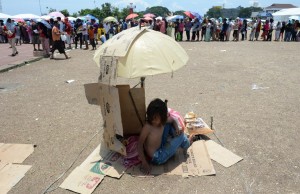
A young evacuee, one of the thousands affected by the stand-off between Philippine government forces and Muslim rebels, shelters from the scorching heat as others queue up for food distribution at an evacuation centre inside a sports complex in Zamboanga, on the southern Philippine island of Mindanao on September 20, 2013. AFP FILE PHOTO
ZAMBOANGA CITY, Philippines—Eleven months after Moro National Liberation Front (MNLF) forces tried to occupy the city, the residents displaced by the conflict still do not know if government has a clear housing plan for them.
“We’re still in the dark. We’ve been staying at the grandstand (Don Joaquin Enriquez Memorial Sports Complex) for almost a year now,” Nurfaisa Mandangan, a 31-year-old mother of four, said in an interview.
“It’s a never-ending struggle for us. My children get sick,” Mandangan added.
Mandangan is among thousands of residents displaced by the fighting between MNLF members and soldiers of the Armed Forces of the Philippines.
Gamal Hassan, an evacuee from the village of Mariki and one of the convenors of the “No To Relocation Movement,” said all of them have been left in limbo.
“We don’t have a clear information on when this so-called rehabilitation will be implemented,” Hassan said, adding that those who received permanent housing units came from the villages of Santa Catalina and Zone 4.
Those from the villages of Rio Hondo and Mariki are still in evacuation centers and transitory sites, according to Hassan.
Apparently dismayed, Peter Deck, head for Mindanao of the United Nations High Commissioner for Refugees (UNHCR), told the Philippine Daily Inquirer in an interview: “We are talking about 11 months later and still the discussion here focuses more on where we could temporarily relocate people instead of how we could find them a permanent durable solution.”
Deck said ideally, the evacuees should return to their places of origin. “Where they were living before is the best place because then they have less need for help,” he said.
The UNHCR official said putting evacuees in a temporary place would not be “a durable solution.”
“You just relocate but you are not improving their situation,” he said.
Deck also questioned the local government’s earlier “no build, no return zone” policy, especially in the villages of Mariki, Rio-Hondo and in the two island sitios of Layag-layag and Leha-leha in Talontalon.
“The no-build, no-return policy was confusing. We learned that it does not apply with NIPAS (National Integrated Protected Areas) Act, contrary to what authorities have been saying and the DENR has not designated these places as protected areas and not considered as hazard zone,” Deck said.
“For not letting people return is unclear, and here we are almost a year later and there are still people in the evacuation centers,” he added.
Zenaida Arevalo, regional director of the Department of Social Welfare and Development in Western Mindanao, admitted to the INQUIRER that they “are still in the restorative stage.”
Arevalo said they could not immediately relocate the evacuees to permanent sites “due to some factors” like problems in acquisition of lands.
Data provided by Arevalo counted 15,131 evacuees as of August 11.
“At least every week we have movements and we are hoping to clear the RT Lim Boulevard before September 9,” Arevalo said.
RELATED STORIES
DSWD faces probe for neglecting Zamboanga siege evacuees
Sona wrong on Zamboanga housing finish
Zamboanga siege heroes recognized
US ambassador says GIs helped fight Zamboanga terror